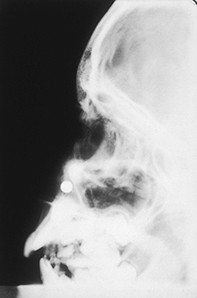How to remove a foreign body from a child’s nose
General considerations
Unilateral purulent rhinorrhoea in a child suggests the presence of a foreign body until proved otherwise.
Vegetable matter, beads, rubbers and many other objects can be inserted into the nose. Possibly the most dangerous foreign body is an alkaline battery – it emits a low direct current flow that causes tissue lysis and necrosis and can erode the nasal septum within a few hours, leaving a permanent septal perforation and possibly significant cosmetic deformity due to septal collapse. It is therefore important to determine the nature of the foreign body rapidly. If removal of the foreign body is not immediately possible, an x-ray of the nose (occipitofrontal and lateral views) may help by at least determining if a battery is present (Figure 1). If a battery is present, removal must be organised on an emergency basis.

